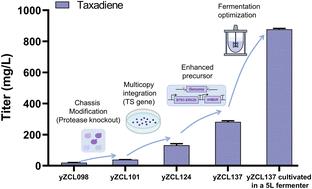Improving the expression of taxadiene synthase to enhance the titer of taxadiene in Saccharomyces cerevisiae†
IF 9.2
1区 化学
Q1 CHEMISTRY, MULTIDISCIPLINARY
引用次数: 0
Abstract
Taxadiene is an important precursor of paclitaxel. However, its low yield in eukaryotic systems limits its biosynthesis. This study found that the low yield of taxadiene is likely due to the degradation of expressed taxadiene synthase (TS) in Saccharomyces cerevisiae. The TS expression degradation problem was improved by the knockout of protease PRB1, and the yield of taxadiene was increased by 97% from 19.8 mg L−1 to 39.2 mg L−1. Furthermore, multi-copy integration of the TS gene and enhancement of the geranylgeranyl diphosphate (GGPP) precursor pathway increased the taxadiene titer to 282.4 mg L−1 in a shake flask. Interestingly, enhancing TS expression also decreased the competitive synthesis of geranylgeraniol (GGOH). Finally, the taxadiene titer reached 878.5 mg L−1 after optimising the fed-batch fermentation, which is the highest taxadiene titer reported for eukaryotic microbes. This study alleviated the problems associated with the expression and degradation of heterologous proteins and provided an efficient and green strategy to produce complex natural compounds.

在酿酒酵母(Saccharomyces cerevisiae†)中改进紫杉醇合成酶的表达以提高紫杉醇的滴度
紫杉二烯是紫杉醇的重要前体。然而,真核系统中的低产量限制了它的生物合成。本研究发现,紫杉二烯产量低可能是由于在酿酒酵母(Saccharomyces cerevisiae)中表达的紫杉二烯合成酶(TS)降解所致。通过敲除蛋白酶 PRB1,改善了 TS 的表达降解问题,并将其产量从 19.8 mg L-1 提高到 39.2 mg L-1,提高了 97%。此外,TS 基因的多拷贝整合和精原基二磷酸(GGPP)前体途径的增强使摇瓶中的紫杉醇滴度增加到 282.4 mg L-1。有趣的是,提高 TS 的表达量也会降低香叶醇(GGOH)的竞争性合成。最后,在优化喂料批次发酵后,紫杉醇滴度达到了 878.5 mg L-1,这是目前报道的真核微生物中最高的紫杉醇滴度。这项研究缓解了与异源蛋白表达和降解相关的问题,为生产复杂的天然化合物提供了一种高效、绿色的策略。
本文章由计算机程序翻译,如有差异,请以英文原文为准。
求助全文
约1分钟内获得全文
求助全文
来源期刊

Green Chemistry
化学-化学综合
CiteScore
16.10
自引率
7.10%
发文量
677
审稿时长
1.4 months
期刊介绍:
Green Chemistry is a journal that provides a unique forum for the publication of innovative research on the development of alternative green and sustainable technologies. The scope of Green Chemistry is based on the definition proposed by Anastas and Warner (Green Chemistry: Theory and Practice, P T Anastas and J C Warner, Oxford University Press, Oxford, 1998), which defines green chemistry as the utilisation of a set of principles that reduces or eliminates the use or generation of hazardous substances in the design, manufacture and application of chemical products. Green Chemistry aims to reduce the environmental impact of the chemical enterprise by developing a technology base that is inherently non-toxic to living things and the environment. The journal welcomes submissions on all aspects of research relating to this endeavor and publishes original and significant cutting-edge research that is likely to be of wide general appeal. For a work to be published, it must present a significant advance in green chemistry, including a comparison with existing methods and a demonstration of advantages over those methods.
 求助内容:
求助内容: 应助结果提醒方式:
应助结果提醒方式:


